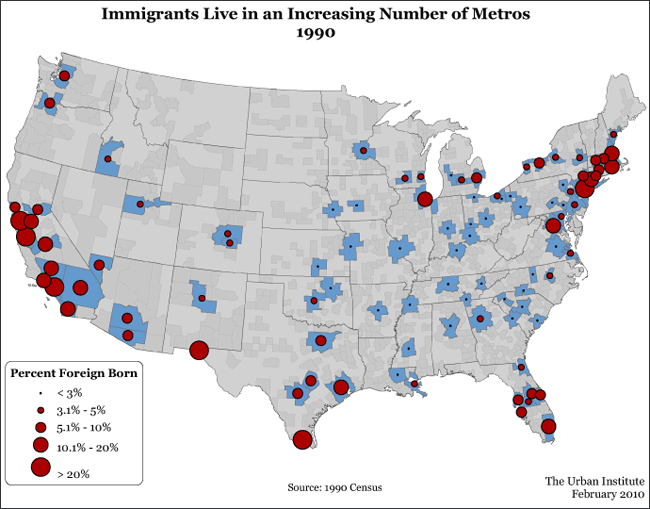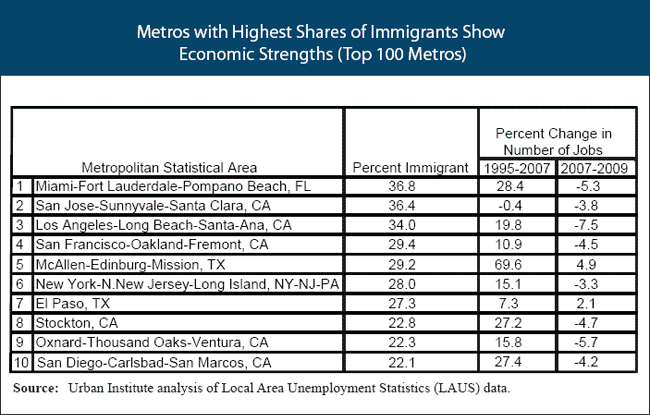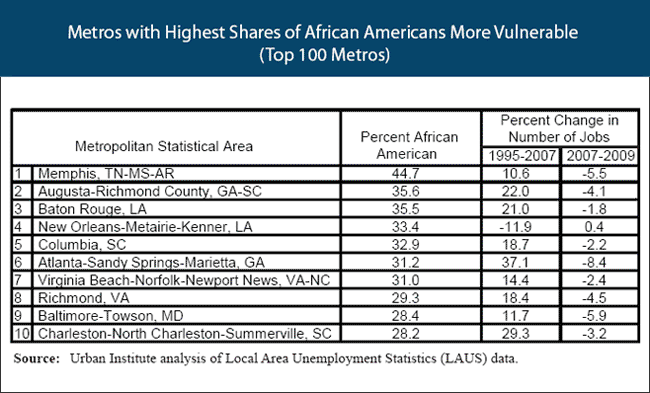
|
|
The New Metropolitan Diversity Immigration Brings Diversity to More of Metro AmericaThe U.S. has seen tremendous immigration growth in the last two decades. The foreign-born share of the population in the 100 largest metropolitan areas climbed from 10.4 to 16.3 percent between 1990 and 2008. In fact, immigration accounted for 38.5 percent of total population growth in these metros.
The surge in immigration?mostly from Latin America and Asia?made metropolitan America more diverse. By 2008, 38.3 percent of people living in the top 100 metros were Hispanic, Asian, Pacific Islander, or African American, compared to only 27.7 percent in 1990. Traditional immigration destinations?Los Angeles, New York, Miami, and Chicago?continued to attract big shares of the foreign-born newcomers. But Southern and Midwestern metropolitan areas?like Atlanta, Greensboro, Indianapolis, and Minneapolis?that had relatively few foreign-born residents 20 years ago have seen their immigrant populations double and triple since. Today, 28 of the nation's top 100 metros are above 40 percent minority. Fourteen are majority minority. Although both immigrants and native-born minorities cluster in metropolitan areas, they don't necessarily live in the same metros. African Americans are heavily concentrated in the metros of the Southeast and industrial Midwest, Hispanics in metros of the Southwest and West. Most Asians and Pacific Islanders are clustered in Western metros. Only the New York metro area has above-average shares of all three groups. The numbers and destinations of new immigrants over the last decade largely mirror patterns of job growth. Overall, the U.S. economy generated nearly 19.5 million new jobs between 1995 and 2007. Of these, nearly 70 percent were in the top 100 metros. Metros in the South?like Charlotte?and West?like Las Vegas?had the most new jobs and the highest percentage increases. They also had relatively large inflows of immigrants. In contrast, many African Americans live in the Midwestern metros where job growth during the 1990s and early 2000s was anemic. Four of the five Midwestern metros with the highest concentrations of African Americans?Detroit, Milwaukee, Cleveland, and St. Louis?have lost more jobs since 2007 than they had gained over the previous 12 years. How are these different types of metros faring in the downturn? The ten with the largest foreign-born population shares are suffering a lesser degree of job loss compared to metros with the largest concentrations of African Americans. The ten with the highest immigrant concentrations on average lost 3.2 percent of jobs between 2007 and 2009, while nine of the 10 metros with the largest concentrations of African Americans have borne greater job losses since 2007?down an average of 4.2 percent. The remaining metro in the top ten, New Orleans, was unusual within the group.1 Although employment distribution in the next economic expansion is difficult to predict, evidence from the last long expansion gives cause for worry. Many metros with large African American populations (and some with concentrations of other minorities) fared less well than the nation as a whole when the economy expanded in the late 1990s. If these same metros don't recover fully from the current recession, many minority workers may be left jobless or underemployed. And rapid growth may pass by metros that saw large influxes of foreign-born workers in the 1990s if the industries that drove growth then can't create needed jobs this time. Either way, if past patterns hold, new immigrants will choose different destinations as the economy expands. |
Experts Feedback
Send us your comments to help further the discussion. Share
Commentaries
|





 |
| 

 Ajay Chaudry
Ajay Chaudry Margaret Simms
Margaret Simms